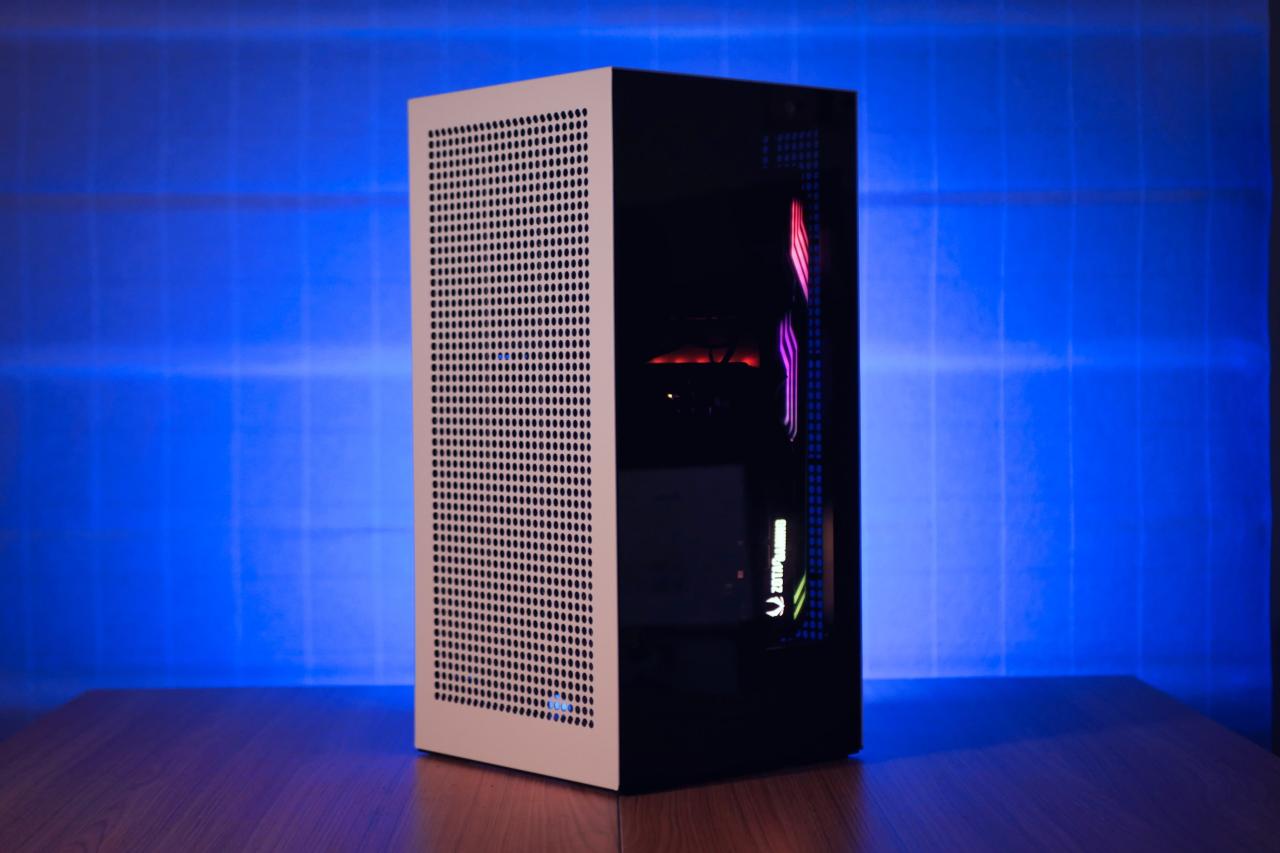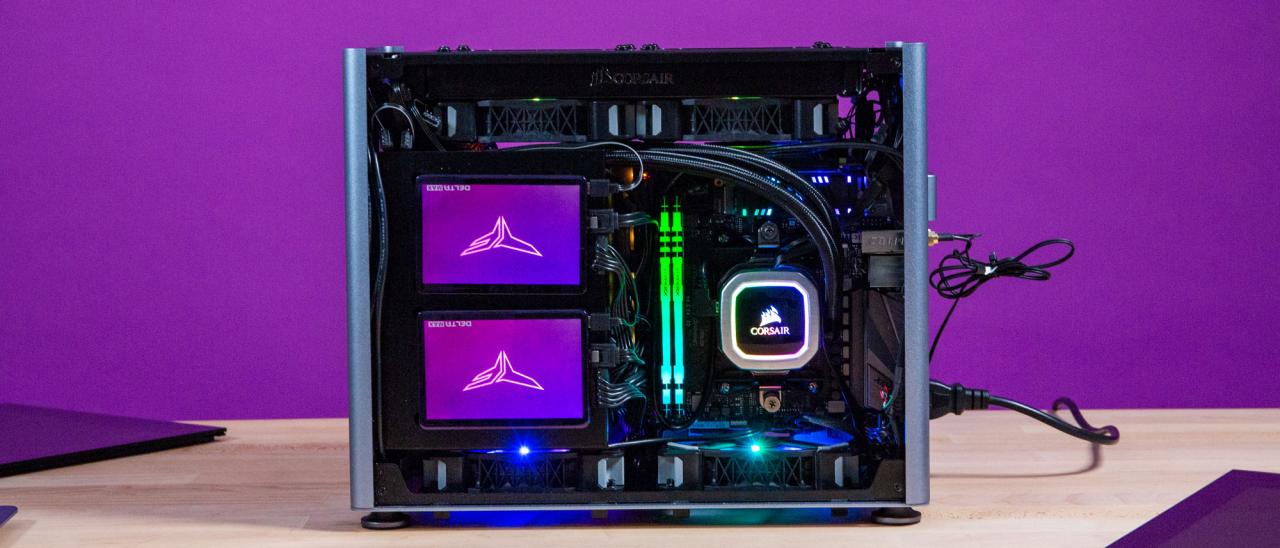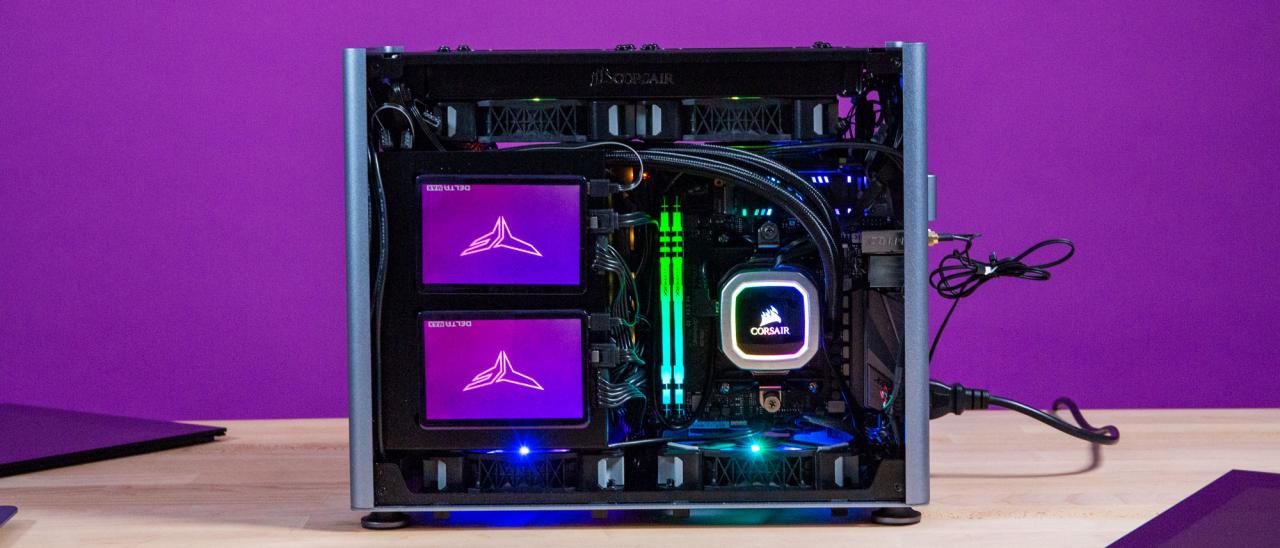Mini ITX gaming PCs offer a compelling blend of performance and space-saving design. They pack a powerful punch into a remarkably compact form factor, making them ideal for those seeking a high-end gaming experience without sacrificing desktop real estate. This exploration delves into the intricacies of these remarkable machines, from component selection to assembly.
From understanding the distinct characteristics of Mini ITX builds to exploring the nuances of component compatibility, this guide provides a comprehensive overview. We’ll also compare Mini ITX to other form factors, outlining the pros and cons of each approach to help you make an informed decision.
Introduction to Mini ITX Gaming PCs

Mini ITX gaming PCs represent a compelling alternative to traditional larger form factor systems. These compact systems offer a unique blend of performance and space-saving design, appealing to users seeking a powerful gaming rig without sacrificing desktop real estate. Their compact footprint allows for greater flexibility in setup, making them ideal for smaller spaces or those seeking a more streamlined aesthetic.Mini ITX gaming PCs are distinguished by their smaller form factor, typically resulting in a smaller footprint compared to desktop PCs using larger form factors like ATX or EATX.
This characteristic is a key differentiator, making them suitable for various configurations and environments. The benefits include space-saving, often lower cost, and potentially improved cooling due to reduced size and increased airflow. However, this smaller size also presents challenges, as component selection and cooling are crucial factors.
Key Characteristics of Mini ITX Gaming PCs
Mini ITX gaming PCs prioritize performance within a constrained space. This necessitates careful component selection to ensure compatibility and performance. Crucially, the smaller size often necessitates more efficient cooling solutions to prevent overheating. Users should also consider the potential for reduced component choices compared to larger form factor builds. These factors impact the overall performance and experience.
Benefits of Choosing a Mini ITX Gaming PC
Mini ITX gaming PCs offer several advantages. They are often more compact and aesthetically pleasing, ideal for smaller spaces or users prioritizing minimalism. Additionally, they can sometimes be more cost-effective due to the reduced component size and materials required. The smaller form factor can lead to better cooling in some scenarios.
Drawbacks of Choosing a Mini ITX Gaming PC
However, the smaller form factor presents drawbacks. Component choices are often more limited, requiring users to prioritize compatibility and performance. Furthermore, cooling solutions need careful consideration to avoid overheating issues. Potential limitations in expansion slots and power supply options should also be factored into the decision.
Mini ITX vs. Larger Form Factor Gaming PCs
Mini ITX gaming PCs offer a significant size advantage compared to larger form factor systems like ATX or EATX. This allows for integration into smaller spaces, which is a critical advantage for users with limited desktop space. However, the larger form factors allow for more extensive component selection and better cooling options, potentially leading to greater performance and upgradeability.
Examples of Popular Mini ITX Gaming PC Builds
Several popular builders offer pre-configured Mini ITX gaming PC options. These builds often focus on balancing performance with the constraints of the form factor. The selection often emphasizes efficient cooling solutions and optimized component choices to maximize performance within the limited space.
Comparison of Mini ITX PC Form Factors
| Form Factor | Dimensions | Component Compatibility | Cooling Considerations |
|---|---|---|---|
| Mini ITX | Typically around 170mm x 170mm | Limited selection of components due to smaller space. Careful consideration for compatibility is crucial. | Cooling solutions must be highly efficient to prevent overheating. Airflow management is paramount. |
| MicroATX | Typically around 244mm x 244mm | More component choices compared to Mini ITX. | Cooling options are generally more diverse, although effective airflow remains crucial. |
| ATX | Typically around 305mm x 244mm | Extensive component choices and greater flexibility. | Excellent cooling potential, allowing for higher-end components. |
| EATX | Typically around 305mm x 330mm | Largest form factor, providing the most comprehensive component options and flexibility. | Best cooling capabilities, accommodating the largest and most powerful components. |
Components for Mini ITX Gaming PCs

Mini ITX gaming PCs offer a compelling blend of performance and space-saving design. However, the compact form factor necessitates careful consideration of components to achieve optimal results without sacrificing gaming experience. Choosing the right components is crucial for balancing performance and budget, as well as ensuring a stable and cool system.Careful component selection is paramount for maximizing performance within the confines of a Mini ITX chassis.
This involves understanding the trade-offs between different components and how they interact to influence overall system performance. Moreover, the cooling solution plays a pivotal role in maintaining stability and preventing overheating, which can significantly impact the lifespan and performance of the PC.
CPU and GPU Selection
Mini ITX systems typically feature smaller heatsinks and less airflow compared to larger cases. This means that CPUs and GPUs with higher TDP (Thermal Design Power) values can present challenges in terms of efficient cooling. The optimal choice depends on the desired level of performance and the cooling solution implemented.
Cooling Solutions
Efficient cooling is critical for Mini ITX builds. Overheating can lead to performance throttling, instability, and even damage to components. Mini ITX cases often have limited airflow space. Therefore, selecting high-quality, high-performance fans and potentially a liquid cooling system is vital to maintaining stable temperatures and peak performance. Active cooling solutions, such as well-designed heatsinks and high-speed fans, are crucial for preventing throttling and maintaining stable system operation under demanding loads.
Storage Options
Mini ITX cases often accommodate smaller storage drives. Solid State Drives (SSDs) are preferred for their speed and efficiency in data transfer, which are vital for a smooth gaming experience. Compact SSDs, such as NVMe drives, are particularly well-suited for Mini ITX builds due to their high-performance capabilities and compact form factor. Opting for high-capacity and high-performance storage solutions is critical for storing large game files and ensuring quick loading times.
CPU/GPU Combinations
The following table presents various CPU/GPU combinations suitable for Mini ITX builds, balancing performance and power consumption. These estimations provide a general idea, but actual performance may vary based on individual configurations and cooling solutions.
| CPU | GPU | Performance (Estimated) | Power Consumption (Estimated) |
|---|---|---|---|
| Intel Core i5-13600K | Nvidia GeForce RTX 4060 | High | Moderate |
| AMD Ryzen 7 7700X | AMD Radeon RX 7700 XT | High | Moderate |
| Intel Core i5-12400 | Nvidia GeForce RTX 3060 | Medium | Low |
| AMD Ryzen 5 7600X | AMD Radeon RX 6700 XT | Medium | Low |
Building and Assembling Mini ITX Gaming PCs
Building a Mini ITX gaming PC offers a unique blend of performance and space-saving design. Careful planning and execution are crucial to maximizing the potential of this compact form factor. The compact nature necessitates meticulous attention to detail, especially in cable management and cooling solutions.This process, while challenging, can be rewarding. The sense of accomplishment in completing a well-built, functional PC, especially within the constraints of a Mini ITX case, is significant.
Choosing the Right Mini ITX Case
Selecting the right Mini ITX case is paramount to a successful build. Consider factors like motherboard compatibility, expansion slot availability, and the size of components you intend to use. Look for cases with features that enhance cable management, such as dedicated cable routing channels and ample space for components. A well-designed case will streamline the build process and contribute to a clean, organized final product.
Ultimately, the case should accommodate your chosen components without compromising their performance or creating unnecessary stress points.
Essential Tools and Supplies
A well-equipped toolkit is essential for a smooth and efficient build. This includes a Phillips head screwdriver, a flathead screwdriver, anti-static wrist strap, and a thermal paste applicator. Specialized tools like a cable tie cutter can also prove helpful. A clean workspace is also a crucial part of the process, preventing static damage to components. Having the necessary tools readily available and in good condition will significantly reduce build time and frustration.
- Phillips head screwdriver: For securing screws on the motherboard, case, and other components.
- Flathead screwdriver: For removing or installing smaller components, like mounting brackets or screws.
- Anti-static wrist strap: Prevents static electricity from damaging sensitive components like the motherboard.
- Thermal paste applicator: For applying thermal paste to CPU and GPU heat sinks for optimal cooling.
- Cable ties and cable tie cutters: For managing and organizing cables within the case.
- Clean workspace: A clean, flat surface free from static electricity is essential.
Assembling the Mini ITX PC
The assembly process is a multi-step procedure. Start with the motherboard, ensuring all components are correctly seated and secured. Carefully install the CPU, RAM, and graphics card, ensuring proper alignment and secure connections. Next, connect the power supply and all necessary cables. Pay close attention to the placement of components and their connections to avoid any potential conflicts.
Cable Management in Mini ITX Cases
Cable management is crucial in Mini ITX builds due to the limited space. Utilize cable ties, zip ties, or cable management channels to keep cables organized and prevent tangles. Proper cable management not only enhances the aesthetic appeal of the build but also improves airflow and reduces the risk of overheating.
- Route cables strategically: Plan cable routes before installing components to minimize stress on connectors and to prevent future issues.
- Use cable ties strategically: Secure cables with cable ties in a way that minimizes stress on connectors and maximizes airflow. Consider the location of fans and other cooling components when placing ties.
- Employ cable management channels: Cases with integrated cable management channels are a valuable asset in minimizing cable clutter. These channels keep cables organized and facilitate a clean build.
Cooling Strategies in Mini ITX Chassis
Cooling is paramount in a confined Mini ITX chassis. Consider the use of high-quality fans for both the CPU and the GPU. Proper airflow is crucial for preventing overheating. Ensure adequate clearance for components to prevent thermal throttling. A well-ventilated case and a strategically placed fan can make a significant difference in keeping components at optimal operating temperatures.
- Properly-sized fans: Employ fans that are optimized for the size of the case and the components within.
- Case airflow: Ensure the case design facilitates good airflow to effectively dissipate heat generated by components.
- Active cooling: Use a combination of fans and heatsinks for components like the CPU and GPU to ensure consistent cooling.
Final Summary
In conclusion, mini ITX gaming PCs represent a compelling option for gamers seeking a powerful and compact solution. By carefully considering component choices, cooling strategies, and assembly techniques, you can build a truly impressive gaming machine that fits seamlessly into your workspace. This guide provides the essential knowledge to navigate the nuances of this exciting form factor.
FAQ Compilation
What are the typical size differences between Mini ITX, MicroATX, and EATX form factors?
Mini ITX is the smallest, followed by MicroATX, and then EATX, which is the largest. The differences in size directly impact component compatibility and cooling solutions.
What are some common cooling solutions for Mini ITX builds?
Mini ITX cases often feature smaller, but equally effective, cooling solutions like smaller air coolers and efficient liquid cooling systems. Proper airflow is crucial.
What are some crucial considerations when choosing a Mini ITX case?
Prioritize cases with good airflow and cable management features. Internal space for components and ease of assembly are also important factors.
What are some of the most important tools for assembling a Mini ITX gaming PC?
Essential tools include screwdrivers, anti-static wrist straps, and possibly a thermal paste applicator. Following proper assembly procedures is also vital.






